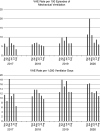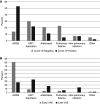Incidence, Characteristics, and Outcomes of Ventilator-associated Events during the COVID-19 Pandemic
- PMID: 34170781
- PMCID: PMC8787787
- DOI: 10.1513/AnnalsATS.202103-364OC
Incidence, Characteristics, and Outcomes of Ventilator-associated Events during the COVID-19 Pandemic
Abstract
Rationale: Ventilator-associated event (VAE) surveillance provides an objective means to measure and compare complications that develop during mechanical ventilation by identifying patients with sustained increases in ventilator settings after a period of stable or decreasing ventilator settings. The impact of the coronavirus disease (COVID-19) pandemic on VAE rates and characteristics is unknown. Objectives: To compare the incidence, causes, and outcomes of VAE during the COVID-19 pandemic year versus prepandemic years and among ventilated patients with and without COVID-19. Methods: In this retrospective cohort study of mechanically ventilated adults at four academic and community hospitals in Massachusetts, we compared VAE incidence rates between March 1 and August 31 for each year from 2017 to 2020 (corresponding to the time frame of the pandemic first wave in 2020) and among COVID-19-positive and COVID-19-negative patients in 2020. The medical records of 200 randomly selected patients with VAEs in 2020 (100 with COVID-19 and 100 without COVID-19) were analyzed to compare conditions precipitating VAEs in patients with versus without COVID-19. Results: VAEs per 100 episodes of mechanical ventilation were more common in 2020 than in prior years (11.2 vs. 6.7; P < 0.01) but the rate of VAEs per 1,000 ventilator-days was similar (14.2 vs. 12.7; P = 0.08). VAEs were more frequent in COVID-19-positive patients than in COVID-19-negative patients in 2020 (29.0 vs. 7.1 per 100 ventilator episodes [P < 0.01] and 17.2 vs. 12.2 per 1,000 ventilator-days [P < 0.01]). Compared with patients without COVID-19 with VAEs, patients with COVID-19 and VAEs had similar rates of infection-related ventilator-associated complications, longer median durations of mechanical ventilation (22 vs. 14 d; P < 0.01), and similar in-hospital mortality (30% vs. 38%; P = 0.15). Progressive acute respiratory distress syndrome (ARDS) accounted for 53% of VAEs in patients with COVID-19, whereas it accounted for 14% of VAEs among patients without COVID-19. Conclusions: VAE rates per 100 episodes of mechanical ventilation and per 1,000 ventilator-days were higher among COVID-19-positive patients than among COVID-19-negative patients. Over 50% of VAEs in patients with COVID-19 were caused by progressive ARDS, whereas less than 15% of VAEs in patients without COVID-19 were caused by progressive ARDS. These findings provide insight into the natural history of COVID-19 in ventilated patients and may inform targeted strategies to mitigate complications in this population.
Keywords: COVID-19; SARS-CoV-2; mechanical ventilation; ventilator-associated complication; ventilator-associated event.
Figures


Similar articles
-
The epidemiology and clinical outcomes of ventilator-associated events among 20,769 mechanically ventilated patients at intensive care units: an observational study.Crit Care. 2021 Feb 2;25(1):44. doi: 10.1186/s13054-021-03484-x. Crit Care. 2021. PMID: 33531078 Free PMC article.
-
Changes in the epidemiology of ventilator-associated events over the course of the coronavirus disease 2019 (COVID-19) pandemic.Infect Control Hosp Epidemiol. 2023 Feb;44(2):305-307. doi: 10.1017/ice.2021.459. Epub 2021 Oct 27. Infect Control Hosp Epidemiol. 2023. PMID: 34702420 Free PMC article.
-
Ventilator-Associated Events: What They Are and What They Are Not.Respir Care. 2019 Aug;64(8):953-961. doi: 10.4187/respcare.07059. Respir Care. 2019. PMID: 31346070 Review.
-
Prevalence, Clinical Characteristics, and Outcomes Related to Ventilator-Associated Events in Neurocritically Ill Patients.Neurocrit Care. 2020 Oct;33(2):499-507. doi: 10.1007/s12028-019-00910-5. Neurocrit Care. 2020. PMID: 31974871 Free PMC article.
-
Potential Strategies to Prevent Ventilator-associated Events.Am J Respir Crit Care Med. 2015 Dec 15;192(12):1420-30. doi: 10.1164/rccm.201506-1161CI. Am J Respir Crit Care Med. 2015. PMID: 26398835 Review.
Cited by
-
Ventilator-Associated Pneumonia, Ventilator-Associated Events, and Nosocomial Respiratory Viral Infections on the Leeside of the Pandemic.Respir Care. 2024 Jun 28;69(7):854-868. doi: 10.4187/respcare.11961. Respir Care. 2024. PMID: 38806219 Free PMC article. Review.
-
Impact of the Severe acute respiratory syndrome coronavirus 2 pandemic on mortality associated with healthcare-associated infections.Antimicrob Steward Healthc Epidemiol. 2023 Aug 29;3(1):e142. doi: 10.1017/ash.2023.409. eCollection 2023. Antimicrob Steward Healthc Epidemiol. 2023. PMID: 37771748 Free PMC article.
-
Ventilator-associated events: From surveillance to optimizing management.J Intensive Med. 2022 Nov 12;3(3):204-211. doi: 10.1016/j.jointm.2022.09.004. eCollection 2023 Jul 31. J Intensive Med. 2022. PMID: 37533808 Free PMC article. Review.
-
Changing Epidemiology of Respiratory Tract Infection during COVID-19 Pandemic.Antibiotics (Basel). 2022 Feb 25;11(3):315. doi: 10.3390/antibiotics11030315. Antibiotics (Basel). 2022. PMID: 35326778 Free PMC article. Review.
-
The Renin-Angiotensin-Aldosterone System, Nitric Oxide, and Hydrogen Sulfide at the Crossroads of Hypertension and COVID-19: Racial Disparities and Outcomes.Int J Mol Sci. 2022 Nov 11;23(22):13895. doi: 10.3390/ijms232213895. Int J Mol Sci. 2022. PMID: 36430371 Free PMC article. Review.
References
-
- Grasselli G, Pesenti A, Cecconi M. Critical care utilization for the COVID-19 outbreak in Lombardy, Italy: early experience and forecast during an emergency response. JAMA . 2020;323:1545–1546. - PubMed
-
- Wu Z, McGoogan JM. Characteristics of and important lessons from the coronavirus disease 2019 (COVID-19) outbreak in China: summary of a report of 72-314 cases from the Chinese Center for Disease Control and Prevention. JAMA . 2020;323:1239–1242. - PubMed
Publication types
MeSH terms
Grants and funding
LinkOut - more resources
Full Text Sources
Medical
Miscellaneous

